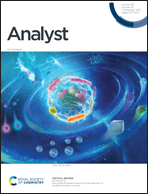Sensitively detecting endogenous homocysteine in human serum and cardiomyocytes with a specific fluorescent probe†
Abstract
The elevated level of homocysteine (Hcy) in circulating blood is generally regarded as a risk factor for a variety of diseases including acute myocardial infarction (AMI), but there is no clear answer to whether circulating Hcy can be used for AMI diagnosis. To address it, here we have designed a tetraazacycle-based fluorescent probe for sensitive detection of endogenous Hcy in AMI patients’ serum and cardiomyocytes, showing a perfect selectivity over other biothiols (e.g. Cys and GSH). It mainly relies on the formation of a stable six-membered ring structure when this probe responds to Hcy, which is accompanied by a weakening of photoinduced electron transfer (PET) that induces a sharp increase in the fluorescence emission. In this way, Hcy can be probed in biofluids with high sensitivity. We then employed this fluorescent sensor to statistically analyze the levels of Hcy in human circulating blood, indicating a big difference between AMI patients and the healthy participants. To tell whether such a difference is applicable to AMI diagnosis, we further compare the expression levels of Hcy in cardiomyocytes and other tissue cells. It reveals a lower level of endogenous Hcy in cardiomyocytes, implying no direct relationship between the elevated Hcy and cardiomyocyte damage. This observation suggests that Hcy in circulating blood cannot be utilized as a potential biomarker for AMI diagnosis, although it is proven as a risk factor for this disease.



 Please wait while we load your content...
Please wait while we load your content...